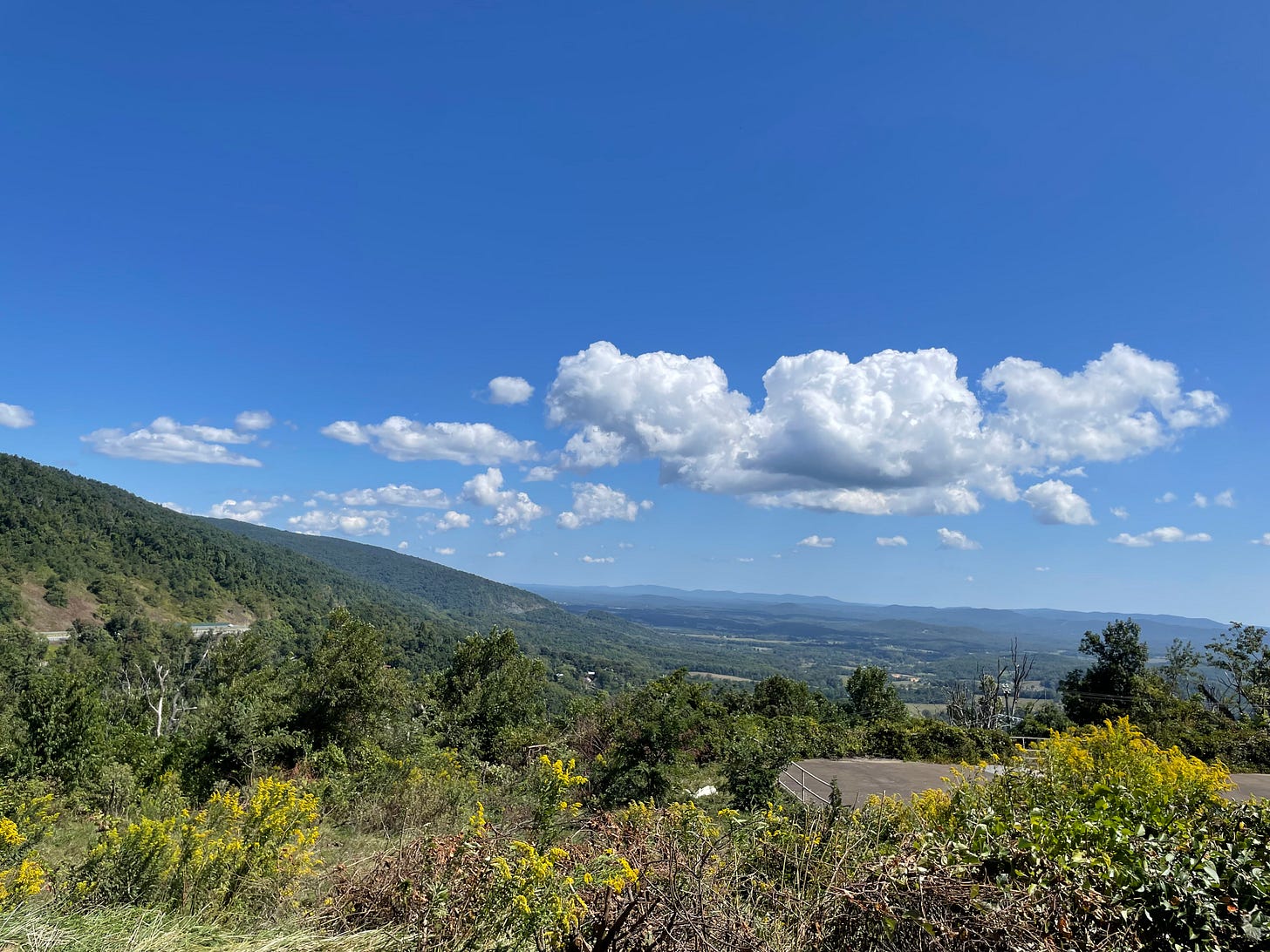Special Education Today Newsletter 3(12)
Last week’s news and info for 18 September 2023
Colleagues, welcome to this week’s edition of the Special Education Today newsletter. It’s the usual.
First, though, I am taking this opportunity to give a shout out to the folks who make the adventure possible. Thanks to those who have paying subscriptions. Y’all keep the boat afloat! I’m especially pleased to note that one subscriber elected the sustainer level of support.
Also, here are important thanks to the many people who have free subscriptions. A lot of the membership can be attributed to subscribers telling others about SET. Thank you! The numbers matter, so invite others to join, even if for free.
John’s week
This past week I spent many hours watching migrating birds of prey on “the mountain,” as I predicted in previous newsletters. The view in this photo is more to east; previous photos looked north, so the ridges in the extreme left of this view are those that were pretty much straight ahead in those photos. The road visible from the left toward the center of this photo is Interstate 64 and, if one followed it down hill one would wind up on the outskirts of C’ville (just a tad beyond the clouds, near the right center of the photo) in about 20 minutes.

Birds often come over Bear Den Mountain, at the center left in the photo. They may catch a thermal to gain altitude or they may simply stream along toward the right in the photo (i.e., south).
One day I left the hawk watch site about 12:30 after a couple-few hours of gawking; I’d seen many of the ~1000 birds that passed the site earlier that morning. Later that day, I read the report for the day. Here is a snippet from it:
After a couple days of small groups of Broad-wings, today was quite the exciting surprise (we're officially in peak week!). An active morning with many medium-size groups of Broad-wings (50-150), mostly quite distant to both the east and west. A few slower hours midday but still consistent small groups moving through. The day really "exploded" around 12:30pm EST with three hours following of nonstop action, lots of kettles and big "rivers" of hawks all over the sky, including many large groups directly overhead! Two massive, continuous "rivers" totaled over 600 BW each. Some birds were flying so high that they were just specks in the binoculars even when straight overhead. Thank gosh for the few clouds we had! Hourly BW Count: 2 (7-8), 92 (8-9), 690 (9-10), 225 (10-11), 262 (11-12), 544 (12-1), 1459 (1-2), 1632 (2-3), 396 (3-4), 216 (4-4:45).
That’s right. I missed 1000s of birds. I left just a bit too early. This is not the first time I’ve made that mistake. Sigh.
I’ll be back on the mountain for several days in the coming week. Mayhaps there will be another surge. Readers can learn about data from hawk watches throughout North America from the Hawk Migration Association of North America and HawkWatch International.
Table of recent contents
Here is a list of the seven posts for the previous week. I sent email notices about six of them (the exception was “Days”). As of the time of this mailing, they are all still “out in the wild,” meaning they are available for free to everyone.
Special Education Today Newsletter 3(11): What was happening during the previous week?
Days: What sorts of special days might help promote acquiring social and academic skills?.
Three versions of change in reading education at Teachers College: What’s going on at Columbia?
B. F. Skinner: Learning to read: What reinforces reading?
Don't make teachers write instructional programs: Don't teachers have enough to do already?
Reducing misbehavior on school buses: Are there ways to improve students' behavior?
Friday photos # 40: Rollanda O'Connor: Who is one great resource about evidence-based reading instructional practices?
Commentary
The contents for the past week reflect the usual sort of mix of stories I cover on SET. There were posts about reading, behavior management, a famous folks in special education, and my personal (i.e., editorial) views. I didn’t have any current news stories for the past week. Obviously, too, I didn’t represent lots of different categories of disabilities, age groups, and topics.
When one thinks about special education, it turns out that there are a lot of topics to cover. Here’s just a simple way to consider the number of topics: There are all the categories of disability (at least 13, on the basis of US law). For each, there are about four age levels (let’s just say early childhood, elementary, secondary, transition, and post-secondary). At each level, there are issues of characteristics, assessment, and intervention. The intersection of each of these dimensions (e.g., assessment of transition for students with autism; characteristics of young children with visual impairments; etc.) produces a lot of cells. That’s a 13-x-4-x-3 matrix, a matrix that’s composed of greater than 150 cells.

I sure don’t want to drop that egg carton. It would be quite a mistake. Still, I’m sure that I omit some topics. Sorry, especially if the overlooked ones are of special interest to particular readers.
So, help me out here. Please let me know what topics you would like to covered in SET.
The usual
Please let me know how it’s going. Send a note to me directly (my name and e-mail addresses are plastered on many walls around the intertubes). If you got this newsletter via your e-mail and you’re a subscriber, you can simply reply and—automagically—your reply will come to me.
Also, here are the usual admonitions: Please remember to wear your seatbelts; take appropriate COVID-19 precautions (e.g., vaccinations, ventilation, hand-washing, masking were needed, etc.); and teach your children well.
—JohnL
SET Editor
Charlottesville
SET should not be confused with a product with a similar name that is published by the Council for Exceptional Children. SET predated CEC’s publication by decades.

